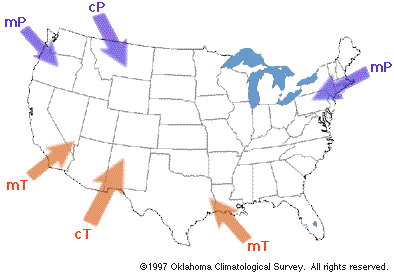|
Air Masses and Fronts
________________ are associated with clouds, wind, and precipitation.

________________ are associated with clouds, wind, and precipitation.
CYCLONES are associated with clouds, wind, and precipitation.

_________________ are associated with dry, clear weather.

_________________ are associated with dry, clear weather.
ANTICYCLONES are associated with dry, clear weather.

_________________ are HIGH pressure centers of dry air. Winds spiral outward from the center and cool air moves downward.

_________________ are HIGH pressure centers of dry air. Winds spiral outward from the center and cool air moves downward.
ANTICYCLONES are HIGH pressure centers of dry air. Winds spiral outward from the center and cool air moves downward.

__________________ are LOW pressure centers. Cooler air blows toward the center and warm air rises.

__________________ are LOW pressure centers. Cooler air blows toward the center and warm air rises.
CYCLONES are LOW pressure centers. Cooler air blows toward the center and warm air rises.

Create a Venn Diagram comparing and contrasting CYCLONES and ANTICYCLONES.

Create a Venn Diagram comparing and contrasting CYCLONES and ANTICYCLONES.

What is a front?

What is a front?
The BOUNDARY where air masses meet/collide.

A fast-moving cold air mass overtaking a warm air mass is called a _________________.

A fast-moving cold air mass overtaking a warm air mass is called a _________________.
COLD FRONT

A warm air mass overtaking a slow-moving cold air mass is called a ___________________.

A warm air mass overtaking a slow-moving cold air mass is called a ___________________.
WARM FRONT

When cold and warm air masses meet but neither can move the other and this results in days of precipitation, what type of front is this called? ______________________

When cold and warm air masses meet but neither can move the other and this results in days of precipitation, what type of front is this called? ______________________
STATIONARY FRONT

When a warm air mass is caught between two cold air masses, this is called a __________________.

When a warm air mass is caught between two cold air masses, this is called a __________________.
OCCLUDED FRONT

Define air mass. 'A huge body of ______ that has similar _______________, ______________, and __________________ at any given ___________________.'

Define air mass. 'A huge body of ______ that has similar _______________, ______________, and __________________ at any given ___________________.'
Air Mass - A huge body of AIR that has similar TEMPERATURE, HUMIDITY, and AIR PRESSURE at any given HEIGHT.

A warm air mass is called ___________________.

A warm air mass is called ___________________.
A warm air mass is called TROPICAL because it forms in the warm tropics.

A cold air mass is called ____________________.

A cold air mass is called ____________________.
A cold air mass is called POLAR because it forms in the polar areas (north of 50* north latitude or south of 50* south latitude)

An air mass that forms over the oceans is called ___________________.

An air mass that forms over the oceans is called ___________________.
An air mass that forms over the oceans is called MARITIME.

An air mass that forms over land is called ___________________.

An air mass that forms over land is called ___________________.
An air mass that forms over land is called CONTINENTAL.

Name Air Mass A. 

Name Air Mass A. 
Maritime Polar

Name Air Mass B. 

Name Air Mass B. 
Continental Polar

Name Air Mass F. 

Name Air Mass F. 
Maritime Tropical

Name Air Mass E. 

Name Air Mass E. 
Continental Tropical

Would Y or X be more likely to receive lake-effect snow? tornados? 

Would Y or X be more likely to receive lake-effect snow? tornados? 
X = Lake Effect Snow Y = Tornados


| Team 1 |
 |
|
 |
|
| Team 2 |
 |
|
 |
|
| Team 3 |
 |
|
 |
|
| Team 4 |
 |
|
 |
|
| Team 5 |
 |
|
 |
|
| Team 6 |
 |
|
 |
|
| Team 7 |
 |
|
 |
|
| Team 8 |
 |
|
 |
|
| Team 9 |
 |
|
 |
|
| Team 10 |
 |
|
 |
|

What Would You Like To Risk?

| Team 1 |
 |
|
 |
|
| Team 2 |
 |
|
 |
|
| Team 3 |
 |
|
 |
|
| Team 4 |
 |
|
 |
|
| Team 5 |
 |
|
 |
|
| Team 6 |
 |
|
 |
|
| Team 7 |
 |
|
 |
|
| Team 8 |
 |
|
 |
|
| Team 9 |
 |
|
 |
|
| Team 10 |
 |
|
 |
|
Go To The Final Question
Final Score:

| Team 1 |
 |
|
 |
|
| Team 2 |
 |
|
 |
|
| Team 3 |
 |
|
 |
|
| Team 4 |
 |
|
 |
|
| Team 5 |
 |
|
 |
|
| Team 6 |
 |
|
 |
|
| Team 7 |
 |
|
 |
|
| Team 8 |
 |
|
 |
|
| Team 9 |
 |
|
 |
|
| Team 10 |
 |
|
 |
|

Edit This Game:

|
|











